Tech Savvy Tips and Tricks
Keyboard Shortcuts
Mac shortcuts
Many of the keyboard shortcuts for Mac OS X are similar to Windows shortcuts. However, instead of the Ctrl and Alt keys, Mac keyboards have Control, Option, and Command keys.
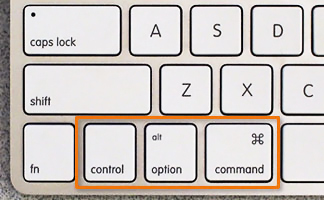 Control, Option, and Command keys on Mac keyboard
Control, Option, and Command keys on Mac keyboardIf you are not using a Mac keyboard, you may not have the Command or Option keys. You will need to experiment with key combinations to perform some keyboard shortcuts.
Working with text
These keyboard shortcuts are useful when working with text in word processor, email, and social media applications (like Twitter). They can help you perform commonly repeated tasks like copying and pasting or bolding text.
- Command+X: Cut the selected text.
- Command+C: Copy the selected text.
- Command+V: Paste the copied or cut text.
- Command+A: Select all text on the page or in the active window.
 Selected text
Selected text - Command+B: Bold the selected text.
- Command+I: Italicize the selected text.
- Command+U: Underline the selected text.
- Command+left arrow: Skip to the beginning of the current line.
- Command+right arrow: Skip to the end of the current line.
- Option+right arrow: Skip to the beginning of the next word. You can press the right arrow multiple times to skip several words.
- Option+left arrow: Skip to the beginning of the previous word. You can press the left arrow multiple times to skip several words.
- Shift+Option+right arrow: Select the next word.
- Shift+Option+left arrow: Select the previous word.
Working with files and applications
You can use keyboard shortcuts to open, close, and switch applications in Finder and from your desktop. When working with a file (like a Microsoft Word document), shortcuts can be used to create new files, find words, and print.
- Option+Command+Esc: Quit a frozen application. This shortcut opens the Force Quit dialog box. You can then select an application and quit it.
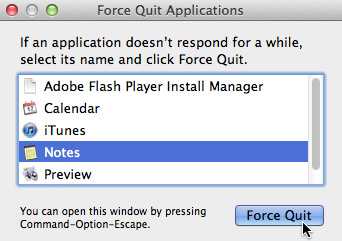 Force Quit dialog box
Force Quit dialog box - Command+Delete: Send a selected file to the Trash.
- Command+Down Arrow (or Command+O): Open a selected application or file.
- Command+N: Create a new file.
- Command+O: Open an existing file.
- Command+P: Print an open file.
- Command+S: Save the current file.
- Command+Z: (or Shift+Command+Z): Undo the previous action. If you'd like to redo the action, press Command+Y.
- Command+F: Find a word or phrase in the current page. This shortcut will make a search box appear. You can then type the text you wish to find. If the word or phrase appears more than once, press Enter to move to the next instance.
 Find box
Find box - Command+- (Command+dash key): Zoom out. When viewing a photo in an application like iPhoto, this shortcut will make the image appear smaller.
- Command+= (Command+equal key): Zoom in. When viewing a photo in an application like iPhoto, this shortcut will make the image appear larger.
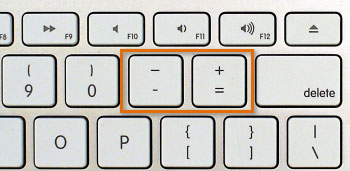 Dash and Equal keys
Dash and Equal keys - Command+Q: Quit the current application.
- Command+W: Close the current file or window.
- Command+Tab: Switch between open applications. This shortcut opens the Application Switcher. While continuing to press the Command key, you can then press Tab again to move between open applications.
 Application Switcher
Application Switcher
Internet shortcuts
These shortcuts are designed for navigating your web browser. Many of the Working with Text shortcuts are also useful online, like the shortcuts for selecting, copying, and pasting text into your web browser’s address bar. Because each web browser is different, some of these shortcuts may vary in their effectiveness.
- Command+F: Find a word or phrase in the current webpage. This shortcut opens the Find toolbar. You can then type the text you wish to find. If the word or phrase appears more than once, press Enter to move to the next instance.
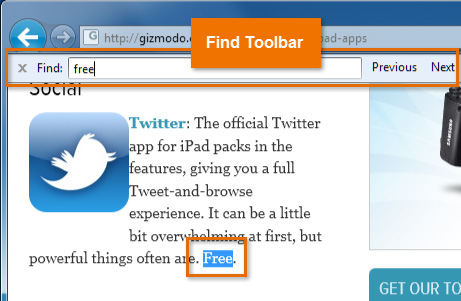 Finding a word
Finding a word - Command+T: Open a new browser tab.
 New browser tab
New browser tab - Command+N: Open a new browser window.
- Command+R: Reload the current browser page.
- Tab: Skip to the next field in a web form. For example, when filling in your address on a web form, pressing tab will move the cursor to the next field. For more information, check out our article Speed Up Your Workflow with the Tab Key.
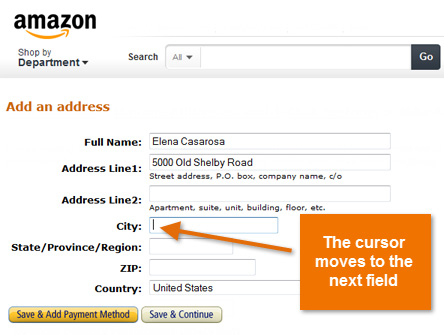 Skipping to the next field in a web form
Skipping to the next field in a web form - Command+D: Bookmark the current page.
- Command+B: View bookmarks.
- Home: Scroll to the top of the webpage.
- End: Scroll to the bottom of the webpage.
Open a word processor like Microsoft Word or TextEdit, and type a few lines of text. Try using keyboard shortcuts to perform the following tasks:
- Select a few of the words. Bold the selected text.
- Undo the text editing, and italicize the selected words instead.
- Find a word or phrase in the document.
- Save the document.
- Close the application.
If you are unable to add formatting in TextEdit, then go to the Format menu and select Make Rich Text.
Try using keyboard shortcuts to perform the following tasks in your web browser.
- Open a new web browser window.
- Move through the webpage to the address bar.
- Type the address of a webpage of your choice. For example, type www.pinterest.com.
- Scroll to the bottom of the page, then scroll back to the top of the page.
- Add the webpage to your bookmarks.
- Copy the web address.
- Open a new web browser tab, and paste the copied link into the address bar.
- Close the web browser.






